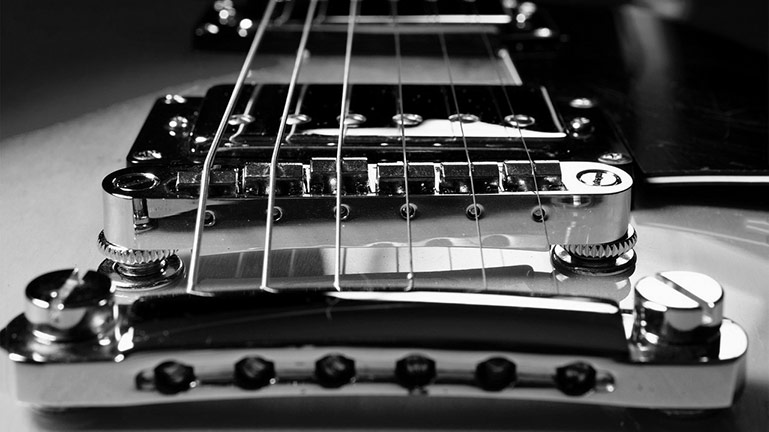Guitar bridges might be one of the most prominent components of a guitar. However, many people, typically beginners, do not put much thought into it. Many people are aware of the two broad types of bridges – fixed and floating. However, almost a dozen different types of bridges are available, and many advanced techniques like vibrato and dive bombs require certain kinds of bridges to be installed on the guitar.
This article will be a definitive guide to all the popular and not-so-popular types of bridges and will be long. I hope it will help you decide what kind you’d like to have on your guitar or know a little more about them than you do now.
There is no “best guitar bridge”. Many bridge types are vastly different, while some have subtle differences. Their impact on sound also ranges from being very pronounced in the case of bridges with tremolo arm and subtle in some cases.
Bridges also affect the tuning and how you play your electric guitar, adding a subtle hint of uniqueness to how you use them. This is why choosing a more suitable bridge for you and your playing style requires some research and thinking.
Fixed & Floating Type Bridges
There are many bridge types, but they can be divided into two primary types – fixed and tremolo/floating bridges. Within these two types, there exist a lot of variants. The choice between a fixed or tremolo bridge would depend greatly on the kind of music you play and your role in the band. The use of tremolo is common among metal and hard-rock guitarists, and lead guitarists in other genres may also use them while doing solos. Some people like to use them more subtly in genres and music style where it is not often used.
Also check out: Different Parts of an Electric Guitar and Their Functions
The following are the eleven bridge types that we’ll be discussing in this article:
Fixed / Hardtail Bridge Types
- Tune-O-Matic Bridges
- Wrap-Around Bridges
Non-Locking Tremolo Bridge Types
- Bigsby Tremolo Bridges
- Fender Synchronized Tremolo Bridges
Locking Tremolo/Floating Bridge Types
- Floyd Rose Locking Tremolo Bridges
- Kahler Tremolo System Bridges
- Stetsbar Bridges
Acoustic Guitar Bridge Types
- Fixed Acoustic Guitar Bridges
- Floating Acoustic Guitar Bridges
Fixed / Hardtail Bridges
Sometimes also called stop-tail bridges, these are fixed bridges secured over to the top of the guitar, usually by two screws. The strings attach directly to or behind the bridge to the stop-bar, in which case the whole design would consist of two parts – the bridge and the stop-bar (tailpiece).
The advantage of a fixed bridge over tremolo bridges is the ability to keep the strings tuning for a longer time. In contrast, tremolos may lose the tuning over some time especially cheaper ones which might be a huge pain in case the tuning goes off mid-performance with heavy playing. Some people also like the intonation of fixed bridges and their ability to achieve better sustain naturally.
On a typical guitar, the bridge’s height (or of each saddle individually) is adjustable, allowing you to easily set or fine-tune the strings’ action (the distance of the strings above the fretboard).
Tune-O-Matic Bridges
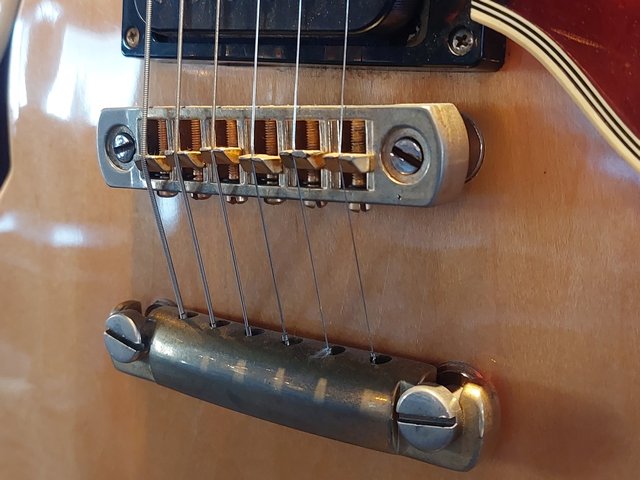
Designed in 1953 and first introduced on the Gibson Super 400, this is one of the most iconic bridge designs by Gibson that had become the standard across almost all electric guitars by Gibson. It consists of two parts the bridge and the tailpiece. The bridge itself has six saddles for the six strings. These allow you to adjust the intonation of strings by turning the screws. The bridge is secured on top of the guitar with two screws that can change the strings’ height above the fretboard (string action). Tune-O-Matic, or TOM for short, are still very popular and used on many of Gibson’s guitar.
A near-imitation of Tune-O-Matic is the Adjust-o-matic by Fender, commonly found in many newer Fender electric guitars. It was initially designed by a company called Gretsch which Fender later acquired. Other guitar manufacturers like Jackson and Squier have similar bridges, sometimes called the “F-Style” bridges.
PROs
- Precise intonation is possible in all six strings separately
- Can change the string action without the need to adjust the truss rod
- Easier to restring
- Relatively stable and able to hold the tuning
- A good amount of natural sustain
CONs
- It can only be used on guitars with a fretboard radius of 12″ or lesser
- The string action can only be set for all the strings, and individual strings cannot be adjusted for height
Wrap-Around Bridges
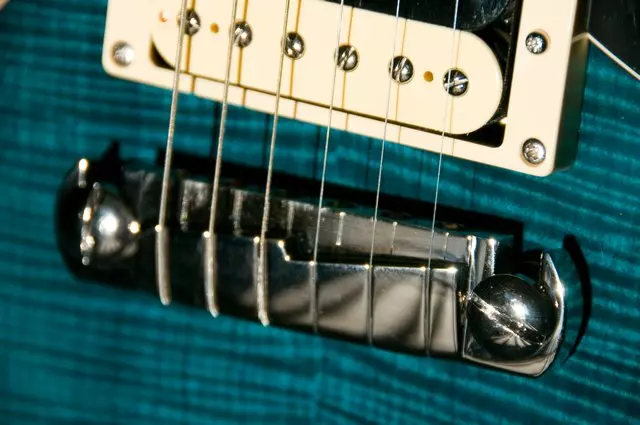
The wrap-around style combines the bridge and stop-bar into one package in which the strings “wrap around” from the top and are attached to the stop-bar, which is a part of the whole bridge system. Combining the bridge saddle and the tailpiece or stop-bar in one package makes this sturdier and less expensive to manufacture. Most of these bridges also have individually-adjustable saddles for fine-tuning the strings’ intonation. They are also pretty easy to put strings on, and since they have been around for decades and are still being used, they are a time-tested design. All around a good bridge for beginners.
PROs
- Very easy to restring
- Inexpensive compared to some other bridges and works quite well for the price
CONs
- It is harder to modify and convert into a tremolo bridge not a big issue if that’s not something you might be looking forward to in the near future
- The string intonation adjustments might not be very accurate or able to hold the adjustments for long
Non-Locking Tremolo Bridge Types
A tremolo or vibrato system is a type of bridge with a lever called the tremolo arm or the whammy bar that lets you temporarily change the pitch of the strings. When engaged, the lever changes the strings’ tension while playing a note or a chord to create effects widespread in metal and hard-rock music like vibrato, dive bomb and pitch bend.
Most tremolo bridges suffer from a common issue of not being able to keep the strings in tune, particularly with heavy use of the tremolo arm. Another type of locking tremolo also exists to counter this problem, which we’ll discuss later in this article. First, let’s look at all the types of famous electric guitar non-locking tremolo or vibrato bridges.
Bigsby Tremolo Bridges
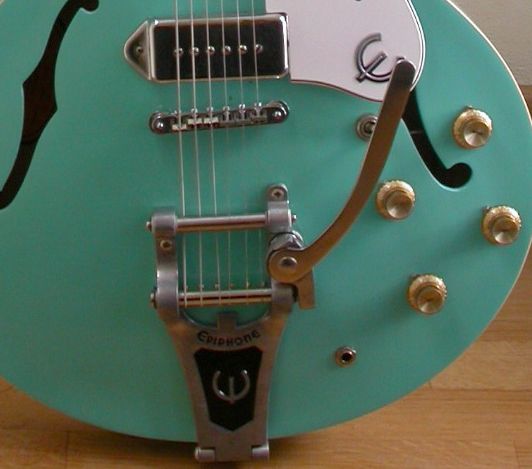
Designed by Paul Bigsby in the 1950s, this bridge was the first commercially successful tremolo system for guitars. More popular in semi-hollow and hollow-body guitars, the unique design has two cylindrical bars, one of which is connected to the arm via a spring and rotates when the lever is pulled up or pushed down. This motion causes the string tension to momentarily change to create pitch variation effects.
There is another spring under the arm to put it back in its original position when it is released. Bigsby tremolo is one of the few vibrato systems suitable for acoustic and semi-acoustic guitars, as the complete bridge and the tailpiece are fixed on the guitar’s top. One downside of this system is its subtlety which is why it is rarely used in solid-body electric guitars. Most metal, heavy-metal musicians opt for solid body guitars, and if they like to have a tremolo, they would often like something that has a very pronounced effect on the pitch. Bigsby, on the other hand, is more prevalent among blues, blues-rock and jazz guitarists.
PROs
- Perfect for people looking for subtle and smooth vibrato effects with exemplary gradualness in pitch shifting
- The iconic look – one of the best-looking tremolos, prominent enough to catch the eye
CONs
- Like many of the old tremolo designs, this one also suffers from tuning stability issues
- Changing the strings is a challenging task for beginners
Fender Synchronized Tremolo Bridges
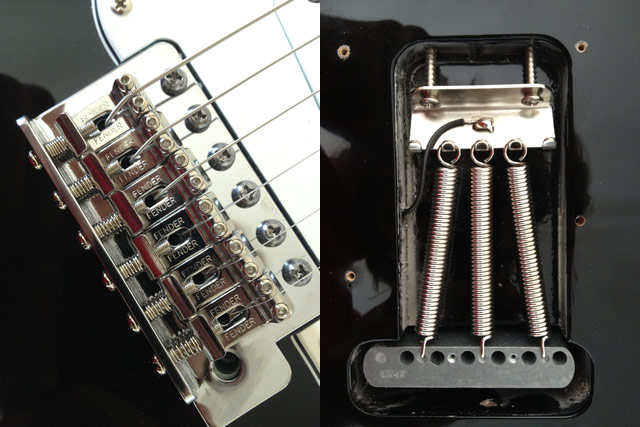
One of the breakthroughs in vibrato design, and still one of the most popular, is the Fender Synchronized tremolo system, first introduced in 1954 (after the Bigsby design).
This design integrates the bridge and tailpiece into one unit and is quite a complex design attached to the guitar body with six screws. The highlight of this design is the ability of the saddles to move along with the strings when the tremolo arm is pushed or pulled.
Behind the system is a chamber consisting of three springs (by default) that counteract the string tension depending on the string gauge, and up to five springs can be attached when using thicker gauge strings. This design makes this bridge produce a greater pitch-change range and better stability against detuning.
You can also use the spring hangers to attach the bridge directly to the body if you do not wish to use the vibrato effect. This would make the bridge more stable and increase the sustain on par with most fixed bridges. Another significant advantage of this design is that the individual saddles can be adjusted for both intonation and string action. This bridge design was and is still very popular with rock musicians and is one of the designs that other manufacturers widely copy.
PROs
- No friction between the strings and the saddles since they move together (in a synchronized manner), proving a smooth vibrato effect
- A far better range of pitch-shift is possible compared to Bigsby or other bridges
- Ability to adjust the individual intonation and action of strings
- Less prone to tuning issues and ability to fix the moving piece onto the guitar for even better stability
CONs
- Expensive
- A popular effect called the dive bomb is not possible with this bridge
Locking Tremolo/Floating Bridge Types
Also called “double locking” tremolos, this design offers one of the best tuning stability in a tremolo design on par with fixed/hardtail designs giving the guitarist ability to make extensive use of the tremolo arm without affecting the tuning.
The name (double) locking comes from the basic design where the strings are “locked” to the nut and the bridge. The bridge is pivoted and held in a neutral place by the strings’ tension from one side and one or more springs that counteract the tension from the other side and balance the bridge.
This design offers far more significant pitch variations, allowing one to go up and down in pitch by as much as a seventh and still be able to keep the tuning even with the constant use of the tremolo arm, which is common in heavy metal and other music styles. Let’s look at the different types of electric guitar bridges which are popular today.
Floyd Rose Locking Tremolo Bridges
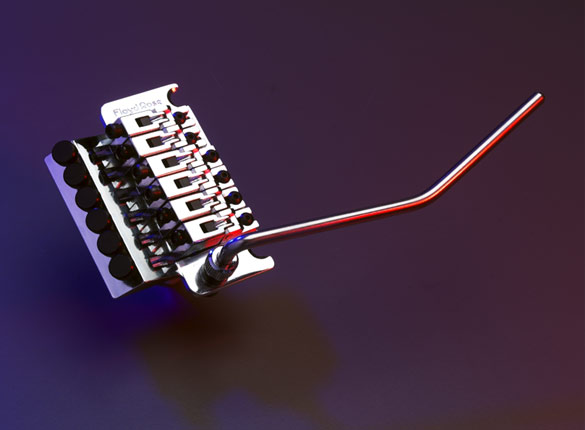
Named after the inventor Floyd D. Rose in 1976, this was the first locking tremolo that revolutionized the vibrato system in the 1980s. Widely considered one of the most crucial guitar innovations, it uses a double locking mechanism to keep the strings in tune even with heavy use of the tremolo arm, common in the heavy metal genre.
Floyd Rose originally hand-made these bridges himself, but with increased popularity, he had to license the manufacturing to other companies like Kramer Guitars and Fender. However, the Floyd Rose bridges are again being manufactured by Floyd Rose (the company).
This was the first design where the strings were “locked” in place at the nut as well as the bridge. The part of the actual bridge where the strings are attached acts as a pivot, with counter-force being applied by a set of springs that keeps the bridge in a neutral position against the force from both sides.
With this design, the action of the strings changes as the tremolo bar is pushed or pulled, and in case of extreme pulling may even touch against the frets and cause a buzzing sound. One of the best features of this design is its stability to keeps the strings perfectly in tune. However, tuning takes a lot of time (iterations) as the overall tension changes with the tuning of each string and disrupts the overall tuning.
PROs
- Excellent tuning stability owing to the locking mechanism
- A great range of pitch shifting is possible
- Ability to increase and decrease the pitch
- Great for performing advanced pitch-shifting techniques such as dive bombs
CONs
- Time-consuming tuning procedure as the tension of each string affects the tuning of the guitar, so several iterations of tuning for each string are required
- Less sustain and a tone that is considered “thin” by some people
Kahler Tremolo System Bridges
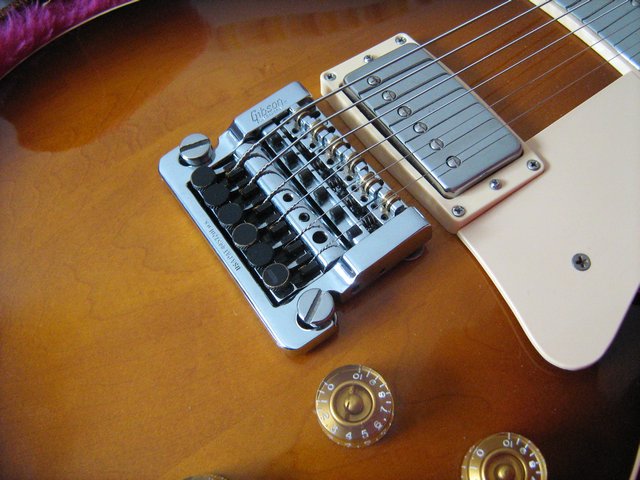
These tremolo systems use a cam design in which a roller with a sliding piece presses down on the strings when the tremolo arm is pushed or pushed. The added tension in the strings changes the pitch produced, creating the vibrato effect. This is, of course, a simplified explanation and the actual manner in which the bridge works is more complex, with many big and small parts. It is known for its smooth vibrato effect and a soft feel to the tremolo arm, which is able to get great feedback from the strings.
PROs
- String action and intonation can be adjusted for each string
- It also offers side-to-side saddle adjustment for optimal string spacing. This system is only found in a few tremolo systems
- Unlike Floyd Rose, the action of the strings remains the same when using pulling or pushing the tremolo arm
CONs
- Expensive
- The string locking system to keep the strings in place is not its strong point, and string slippage happens occasionally
- The single locking mechanism provides worse tuning stability than that of Flyod Rose’s double locking mechanism
Stetsbar Bridges
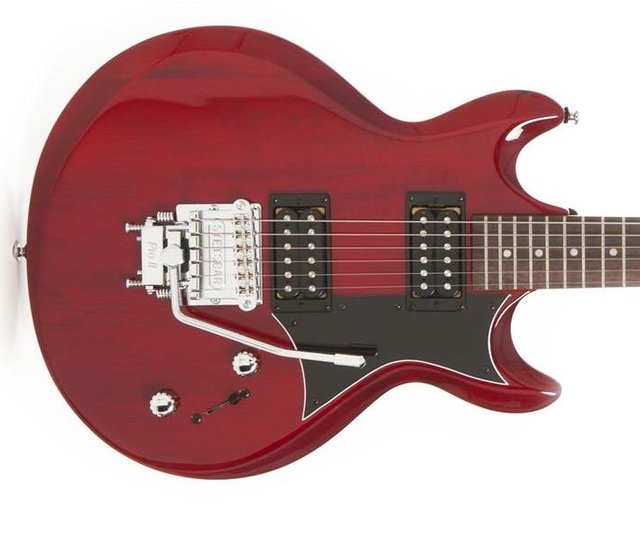
Developed by Eric Stets and named after him, Stetsbar bridges use a roller system with two linear roller bearings for smooth movement of the bridge plate (very similar to a Tune-O-Matic bridge) over the base plate. Like Fender Synchronized Tremolo systems, the bridge and the stop-bar that holds the strings move together, preventing friction of the strings over the saddle. These tremolo bridges are also easy to retrofit onto guitars with a fixed tailpiece, and the installation requires no additional changes to be made.
PROs
- It can be mounted on any guitar, even those with fixed tailpiece
- You get the benefits of the Tune-O-Matic bridge along with having the tremolo
- No permanent modification is required on the guitar to install it
- Newer variants, such as the Stetsbar Pro II, allow on-the-fly drop tuning
CONs
- Suffers from the tuning stability issues
Acoustic Guitar Bridge Types
While electric guitars employ pickups and amps to produce sound, acoustic guitars rely on the soundboard and the hollow chamber to make sound from the strings’ vibration. Since the transmission of the vibrational energy is even more critical in the case of an acoustic guitar to have a loud, audible sound without the need for external amplification, the bridge plays an important role.
When a string (or strings) is strummed, the bridge starts vibrating along. This makes the soundboard vibrate at the same frequency as the strings, making the hollow, resonant chamber produce an audible sound due to how they are designed acoustically.
Most acoustic guitars have a fixed bridge setup, while some may have a floating design. However, a tremolo system is rare, though some add after-market systems.
Fixed Acoustic Guitar Bridges
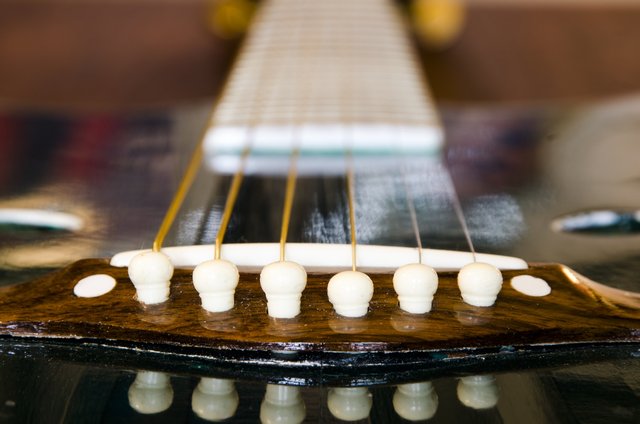
Fixed bridges are the most widely used bridge on acoustic guitars due to their simple design and effectiveness in doing their job. Fixed bridge type on an acoustic constitutes a saddle along with pegs or fasteners fixed to the bridge to hold or lock the strings.
There are separate pegs for each string which are usually loose and kept in their place by the tension of the strings. The saddle has grooves for the strings to keep them in place and is generally made of plastic in inexpensive guitars and bone or ivory in high-end guitars.
The bridge itself is made of hardwood like rosewood in high-end guitars, but some are also made of plastic and other hard synthetic materials. They are usually glued to the guitar’s top or soundboard and are therefore deemed sturdy. These bridges are very stable as far as tuning stability is concerned.
PROs
- Simple and inexpensive design
- It offers great robustness and durability
- Very high tuning stability
- Great sustain, which is a requisite for acoustic guitars
CONs
- Not possible to adjust the intonation or action without making permanent changes to the saddle
Floating Acoustic Guitar Bridges
These bridges are usually found on semi-acoustic guitars having a separate saddle package and tailpiece. The tailpiece is attached to the tail end of the guitar and extends all the way to almost the center of the guitar, just a few inches from the saddle.
The tailpiece is trapezoidal with a bar at one end to which the strings attach and is kept in place with the strings’ tension. It is possible to change the action of the strings by adjusting the nut at both ends of the saddle piece. The tone produced is rounder and woodier popular with jazz and blues players, but they do not have as much sustain as the fixed bridges discussed above.
Some common floating-type semi-acoustic guitar bridges are the Bigsby and Gretsch (similar in design to Bigsby) bridges, mostly found on Gretsch semi-acoustic/semi-hollow guitars.
PROs
- Ability to change the action of the strings very easily
- Good in terms of keeping the strings in tune
- Distinct tone liked by certain musicians
CONs
- Sustain is not very good
Summary
Most electric guitars come with fixed bridges, and if you’re not into the vibrato effect, you can play great music with the bridge that comes with a decent guitar. You can replace the original with Tune-O-Matic if you want something sturdy but more versatile and like to keep your guitar with fine-tuned action and intonation that suits you. Many of Gibson’s guitars also come factory-fitted with these bridges, and you can instead opt to buy these guitars if you haven’t already.
Tremolo or vibrato system, on the other hand, will suit someone more into metal and hard rock genres. It would make interesting effects like vibrato and dive bombs possible, extending your playing capabilities. Something like Bigsby would be easier for someone starting out and trying to experiment with tremolo-based bridges, but the lack of a larger pitch change could be a deal breaker. Floyd Rose could also be a good choice with its double-locking mechanism, but they are expensive. You can also go for the Fender Strats that come with its Synchronized Tremolo with a removable tremolo arm. You can detach the arm and tighten a few screws to make it effectively a hardtail bridge.
In the end, every bridge has its set of advantages and disadvantages. Your choice would depend on your preferences and playing style. This article provides you with all the information required to make a solid decision to make your choice from the different types of guitar bridges available. You can even go to a guitar store and test a few guitars with various bridges to get a feel of them.
In any case, good luck!
Photo credits:
- Wrap-Around Bridge by Art Bromage, CC BY-SA 2.0, via Wikimedia Commons
- Bigsby Vibrato System by User:Maxo, CC BY-SA 3.0, via Wikimedia Commons
- Fender Synchronized Tremolo by Zzerox at the English-language Wikipedia, GFDL, via Wikimedia Commons
- Kahler Tremolo by Mecanismo, GFDL 1.2, via Wikimedia Commons
- Stetsbar Tremolo by Madisonandfifth, CC BY-SA 4.0, via Wikimedia Commons

